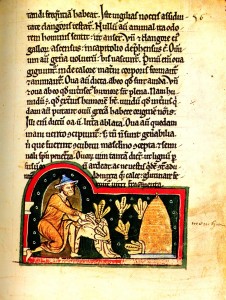
Bees /apes/ 9.5X4.5 cm
The story of the bees is one of the fullest in the bestiary. Accounts from Pliny /XI.5.4—20.23/, St.Ambrose /V.58.21—70/, Isidor /XII.VIII.I/ the medieval compilers, Pseudo-Hugh among them /III.38/, describe their way of life, their art of making honey, the construction of their hives, the laws and customs of the bees’ kingdom. They admire their dexterity in “building hives,,. What architect has taught them this? — wonders the author. Telling us about the industry of the bees he refers us to the Holy Writ and paraphrases the Proverbs of Solomon calling upon Man to follow the example of the ant /Prov.6:6/, though he does not repeat the frequent mention of the honey being compared with the wisdom of man or with nice words, so sweet to one’s soul /Prov.l6:24; 24:13/. The bestiary says that eating honey is healthy and admires the wisdom and the virtue of the bees’ kingdom.
Albert the Great, in his description of the life of bees, proceeds from Aristotle and Avicenna /XXVI.1.1/. Brunetto Latini gives a free rendering of the text of the bestiary /I.V.155/.
In the bestiaries of the twelfth and thirteenth century the traditional miniature shows a swarming beehive, whereas in the Saint Petersburg and New York bestiaries the text is illuminated by a picture of a bee-master letting the bees out of his sack into the hive. Preserving Romanesque decorative conventionality, the miniature is one of the earliest representation of agricultural theme in medieval art.





